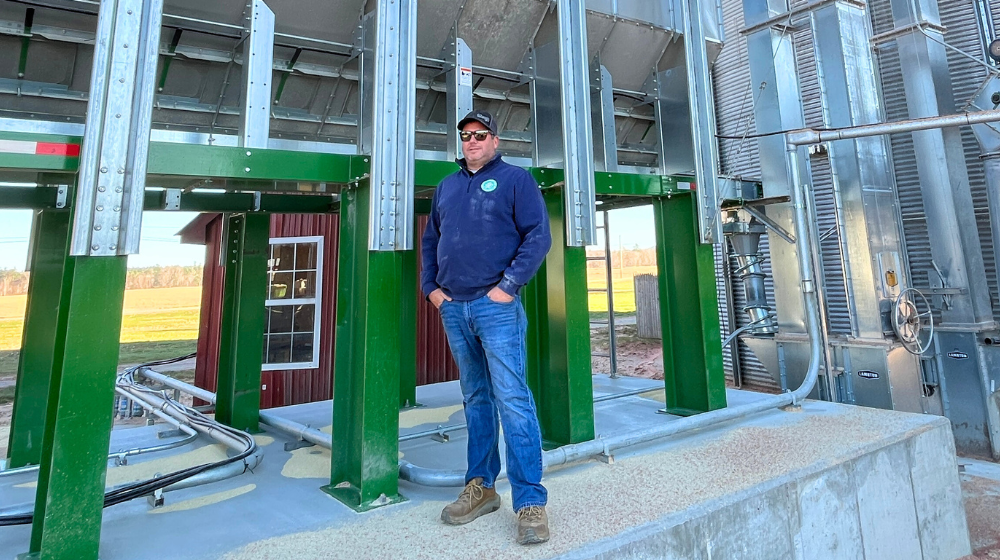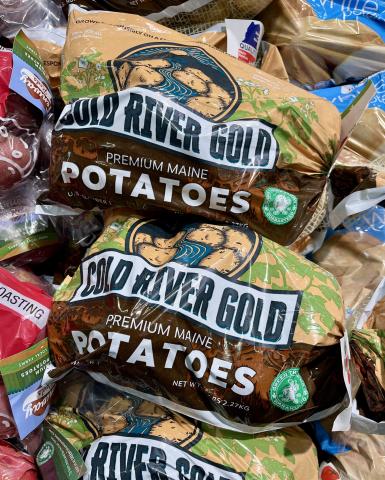
Soil Health, Bottom Line, and Maine Livestock
All Benefit from REAP Grant
Green Thumb Farms is a familiar name to many Mainers. The farm’s “Cold River Gold” potatoes are found in abundance in New England supermarkets each fall and winter. The family-owned farm in the Western Maine town of Fryeburg grows several varieties of potatoes and is the largest fresh pack potato grower outside of Aroostook County. The farm produces other products as well, including about 225,000 bushels of feed corn annually. It was this latter crop that brought Green Thumb Farms’ President, Jim Pitreau, to USDA Rural Development. He was looking for ways to lower the cost of the feed corn the farm produced to keep it a competitive commodity.
It might seem surprising to consumers that a well-established farm with a market crop like premium potatoes would even produce animal feed. But the Saco River Valley is well-suited for corn, and it is beneficial for the farm’s soil health to rotate between crops each year. Plus, there is a big demand for the product to feed livestock. In fact, Maine is “in deficit status” in terms of livestock feed, according to Pitreau. Harvesting 1300 acres of corn annually makes a measurable contribution to the local supply available through feed distributors.
Unlike sweet corn, feed corn can be left in the field well into fall. Farmers use combine harvesters, large machines that cut, thresh, and capture the kernels of corn from the plant material, to bring in the crop. Once harvested, even though the corn has begun to dry in the field, it must then be dried further to a consistent level for long-term storage.
Typically, the equipment used to dry the corn runs on propane. At Green Thumb Farms, the amount of propane needed to dry the corn from those 1300 acres was “crazy,” according to Pitreau. Furthermore, with their original, twenty-year-old equipment it was a slow process, taking an average of two months to dry the entire crop.
This is where USDA Rural Development enters the picture. In 2023, Pitreau applied for a Rural Energy for America Program grant to help the farm purchase a highly energy-efficient grain dryer. His application was strong, and that fall he learned the farm would receive a $233K grant to cover half the cost of the $466K equipment. (Historically REAP has covered 25% to 40% of project costs, but under the Inflation Reduction Act it has covered up to 50%.) It was installed in August of 2024 and was fully operational for the fall harvest.
After completing his first season with the new grain dryer, Pitreau achieved the results he’d been seeking. While the equipment still used 1700-1800 gallons of propane per day, the entire process was complete in just two weeks rather than ten. The fuel savings (anticipated to be roughly $28K per year) were huge. This will enable the farm to keep its price per bushel of corn lower, keeping the product more affordable for local livestock farmers.

Though Pitreau pursued the project for the cost savings, he quickly realized that the project brought what he calls “a huge unforeseen benefit.” Because the high-efficiency grain dryer is so effective and is highly automated, the farm’s entire corn crop was harvested and dried in just a couple of weeks. Accelerating the process meant that the harvested fields were empty and ready for preparatory work in September. With warm weather and staff available, Pitreau was able to get them tilled and planted with cover crops that thrived in the fall conditions. The 1300 acres that had been planted with corn were prepped and ready for spring by mid-October, which is much better in terms of soil health and more efficient for the farm.
Located in a historically agricultural area, the farm’s grain dryer and silos are about a quarter mile or more from the few neighbors in the area. But even though they are a good distance away, the neighbors appreciate the high-efficiency grain dryer too. Its fans still run from 6 am until midnight while the grain is being dried. But with the vastly shortened drying time, those fans are running eight fewer weeks each year. So, increased community goodwill was another benefit of the project.
Having worked with USDA’s Natural Resource Conservation Service and Farm Service Agency as well as Rural Development, Pitreau has had good experiences in the past with the Department. Applying for federal grants is difficult but worthwhile. “The programs are amazing, but you have to ask questions,” he says. “You need good USDA people who can answer those questions. They want you to find a fit and get the funds you need.”
This is the first such grain dryer in Maine and a major investment for Green Thumb Farms. Says Pitreau, “We’re excited and very proud of it. We’re proud to have done this with USDA. This is a big deal for a company like mine.” The financial savings mean the farm’s rotation crop is a viable product that is useful to other Maine farms. The energy savings also help the farm’s balance sheet. But for Pitreau, it’s a big deal for other reasons too.
“Maine is a natural resources state, and it’s so important that we keep it that way,” he said. “But we’re increasingly concerned that our natural resources are being fractured. It’s important we protect them, and to make sure we’re doing right by the community. My job is to protect this farmland at all costs, keeping it productive and supplying food, and USDA has been a great partner. We now have a fourth generation that is just getting started on the farm today, and I hope they may continue to have the same pride in this work.”
###
USDA is an equal opportunity provider, employer and lender.

